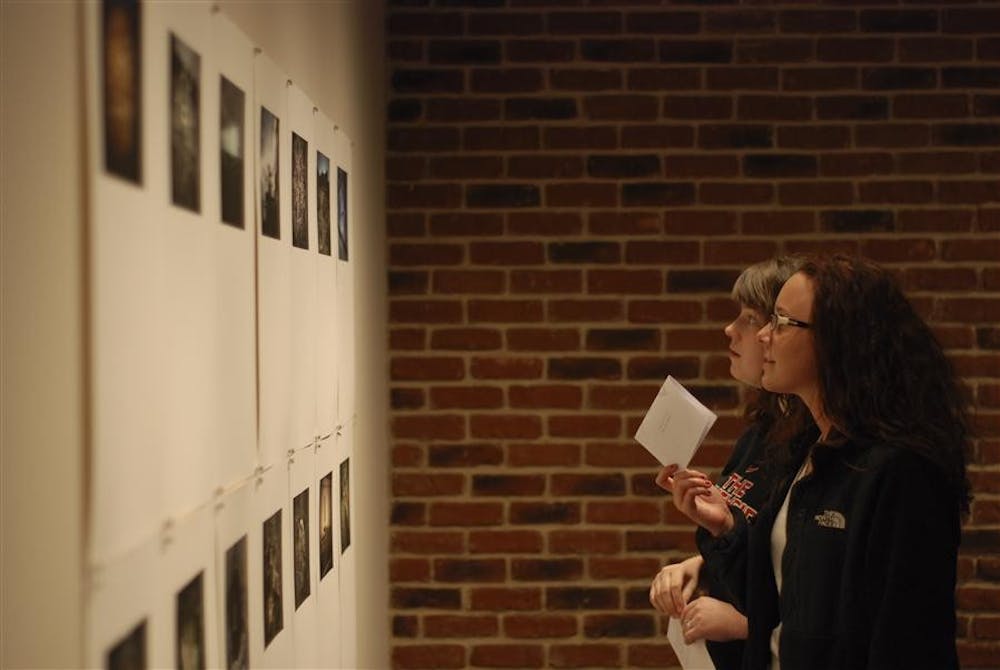A look at the results of war is on display in Bloomington as photographer Osamu James Nakagawa’s new exhibit, “Remains,” is on display at the Pictura Gallery through Dec. 31.
The exhibit contains 46 pictures taken around mainland Japan and Okinawa.
“I stretch history from past to present,” Nakagawa said.
Each picture is on heavyweight paper with an English word and Japanese symbol underneath it.
“The fact that they (the words) are imprinted into the paper gives it a textural feel,” Pictura Assistant Curator Mia Dalglish said. “It’s sort of reminiscent of grave stones or a war memorial that has names imprinted into stone.”
Each photograph has one or two words underneath it describing it. Having the English and Japanese words, Dalglish said, shows the connection the nations have.
“Each piece is almost sort of a little memorial to the object in it,” Dalglish said.
This presentation appealed to local resident Susan Klein.
“It’s very moving,” she said. “The whole effect is very stunning.”
Nakagawa was born in New York City and raised in Tokyo. He attended the University of St. Thomas-Houston and the University of Houston.
He received a John Simon Guggenheim Fellowship in 2009 and was honored with the Best New Photographer Higashikawa award in 2010. He is currently a professor of photography at IU.
Local resident Chris Wallace said he has been following Nakagawa’s work for several years and was surprised by the exhibit.
“This is work like I’ve never seen him produce,” he said.
The photographs show the effects of the Battle of Okinawa. More than 100,000 Japanese troops were killed in the battle, along with thousands of civilians.
The battle lasted 82 days and was the biggest amphibious assault of the war in the Pacific.
Local resident Kevin O. Mooney said he was drawn to the exhibit for the technical beauty of the photography but thought the subject matter was profound.
“The imagery reflects how I feel about the actual war,” he said. “The images are beautiful in context of the subject matter.”
This combination appealed to the gallery.
“I think that everyone here really appreciates his ability to merge technical perfection with a very strong conceptual backing,” Dalglish said.
Nakagawa said he did not intend to make a photo collection.
“I was working on my cliffs series, and I would see something that looked interesting, and I would take a picture,” he said.
The exhibit’s name refers to items in the photographs, which Nakagawa said are remains from the Battle of Okinawa.
“A tree could be remains,” he said. “U.S. occupation is a remain. To me, the city is remains of bombing.”
The title also refers to the way he put the exhibit together.
One night, Nakagawa said he could not sleep. He was worried about the cliffs series he was working on and while thinking about it, remembered the photographs he took at the same time.
“I started sketching from memory. I had about 35 pictures, but I only had remains of
memory.”
He said it is difficult to balance his time between teaching, working on projects and coming up with new project ideas.
“I’ve been in Bloomington 12 years, so I don’t get to do shows much,” he said.
Nakagawa’s work has been in galleries all over the world. “Remains” premiered last year in Tokyo, but this is its first showing in the United States.
Nakagawa added that he had sold some pieces in Bloomington, which made him realize there was a market for his work.
“My work is very expensive, so I was surprised people here wanted to buy it,” he said.
But the reason he is showing these photographs at Pictura might be more simple than that.
“David’s (the owner’s) wife really liked my work,” he said.
Mooney said he liked the way Nakagawa handled the subject matter in the photographs.
“It would be interesting to see him take photographs of what’s happened in Iraq and Afghanistan,” Mooney said.
Despite the political nature of his photographs, Nakagawa said he does not want to be political.
“I’m not preaching to the viewer,” he said. “I’m not documenting. I’m not a photojournalist. I’m not romanticizing things.”
Professor displays ‘Remains’ of history in photo

Get stories like this in your inbox
Subscribe





